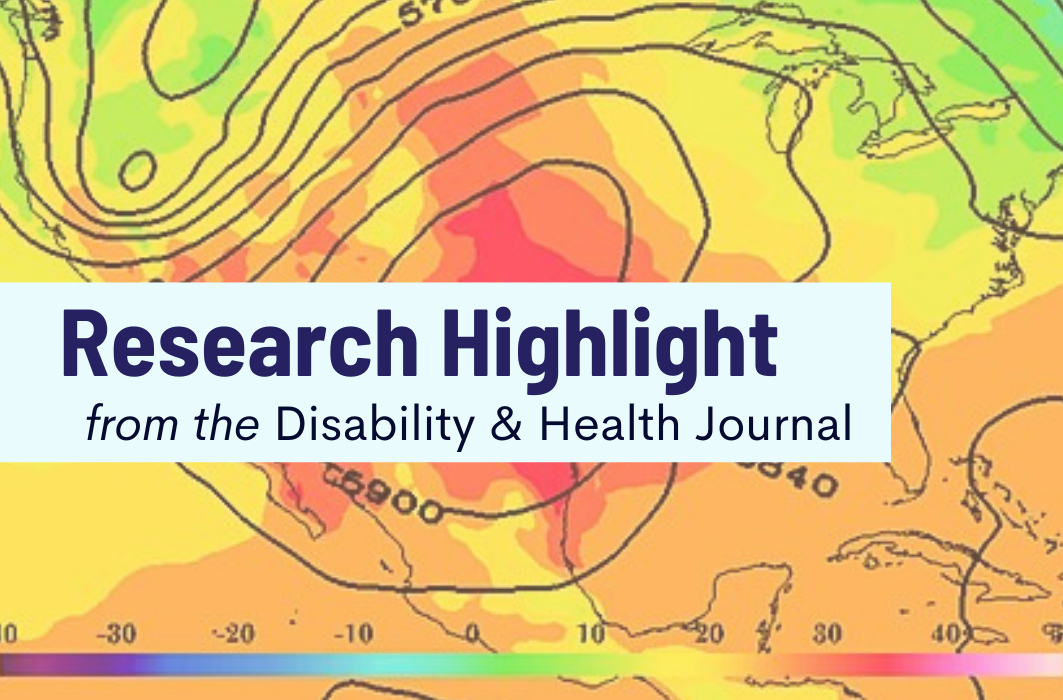How does extreme heat affect the disability community? This study in the Disability & Health Journal looks at the U.S. South as a case study.
This plain language summary is part of a new series sharing highlights from the Disability and Health Journal.
Why was this study done?
Extreme heat affects certain groups more than others. People with disabilities are one of these groups. Very little research exists on how disabled communities are affected by high heat. This study looked at how heats impacts the disability community. It focused on people living in the southern United States. This area has a higher number of people with disabilities. It also has extremely high summer temperatures.
What did this study show?
People with disabilities are more likely to live in areas that have a higher number of heatwaves. This was true for all people with disabilities, regardless of their disability. It was also true regardless of the person’s race, financial situation, or age. People who have difficulty walking were the most likely to be exposed to heat. Exposure to heatwaves is an injustice affecting the disability community as a whole.
What can we learn from this study?
Action should be taken to protect people with disabilities from high heat. The community needs:
- More research on the social impacts of heatwaves on people with disabilities.
- This research to be conducted in other places (in the U.S. and other countries)
- Programs and policies that protect people with disabilities from extreme weather.
Learn more about this study
Climate change is making heatwaves more regular, and more intense. Studies show that some communities are more affected by extreme heat events. Some of the people most affected include those who are racial and ethnic minorities, elders, and low-income. The effects of heat on the disability community has been less studied.
People with disabilities have a greater risk of getting sick from extreme heat. Heat can make current health issues worse, and increase the risk of death. Conditions that affect the brain, lungs, heart and blood can become more severe with heat. Some conditions affect a person’s ability to stay cool. People with psychosocial disabilities are at a greater risk of death during heatwaves. During emergency weather events, important messages might not reach people with disabilities. Not all communications are accessible or made with disabled people in mind.
People with disabilities are more likely to live in places with air pollution. They also experience poverty and unemployment more than the nondisabled population. There are lower levels of education in the disability community. This may also contribute to poor health outcomes during heatwaves.
People with disabilities often need supports that are affected by extreme weather. These supports can include personal care and meal delivery. People might also need to find places to stay cool. When the electricity goes out during a storm, staying cool at home becomes a safety issue. Some people may not be able to afford or have access to air conditioning. Power outages can affect access to medications and assistive communication devices. It can also affect any medical equipment that runs on electricity.
These challenges are increased if healthcare resources are not available. Heatwaves can overwhelm local transportation and communication systems. Healthcare and emergency response services may be limited with high demand. A person who lives in a place with lots of extreme heat may face these challenges more often.
Past research has treated the disability community like a homogenous group. Different disability groups have different unique risks. This study focused on the U.S. South for a few reasons:
- This area is the most populated U.S. census region and includes 16 states.
- This area has had extremely high summer temperatures recently.
- The South has the highest rate of disability in the U.S.
- The South also has a high number of people with disabilities. Over 40% of the U.S. disability population lives in the South.
Future studies should examine why people with disabilities are more likely to live in areas with more heatwaves. Researchers could look at things like the history of housing policy to learn more. Policy planning related to heatwaves needs to include disabled residents. They are an important stakeholder group for inclusive disaster preparedness.
Key Definitions
- Heatwave – a period of extreme heat and humidity that lasts two or more days.
- Disability – Disability data in this study came from the 2021 American Community Survey. This survey is done annually by the U.S. Census Bureau. It surveys people across the country. It asks questions about social, economic, demographic, disability, and housing. The ACS disability definition includes people who struggle with hearing, vision, cognition, walking, self-care, and/or independent living.
